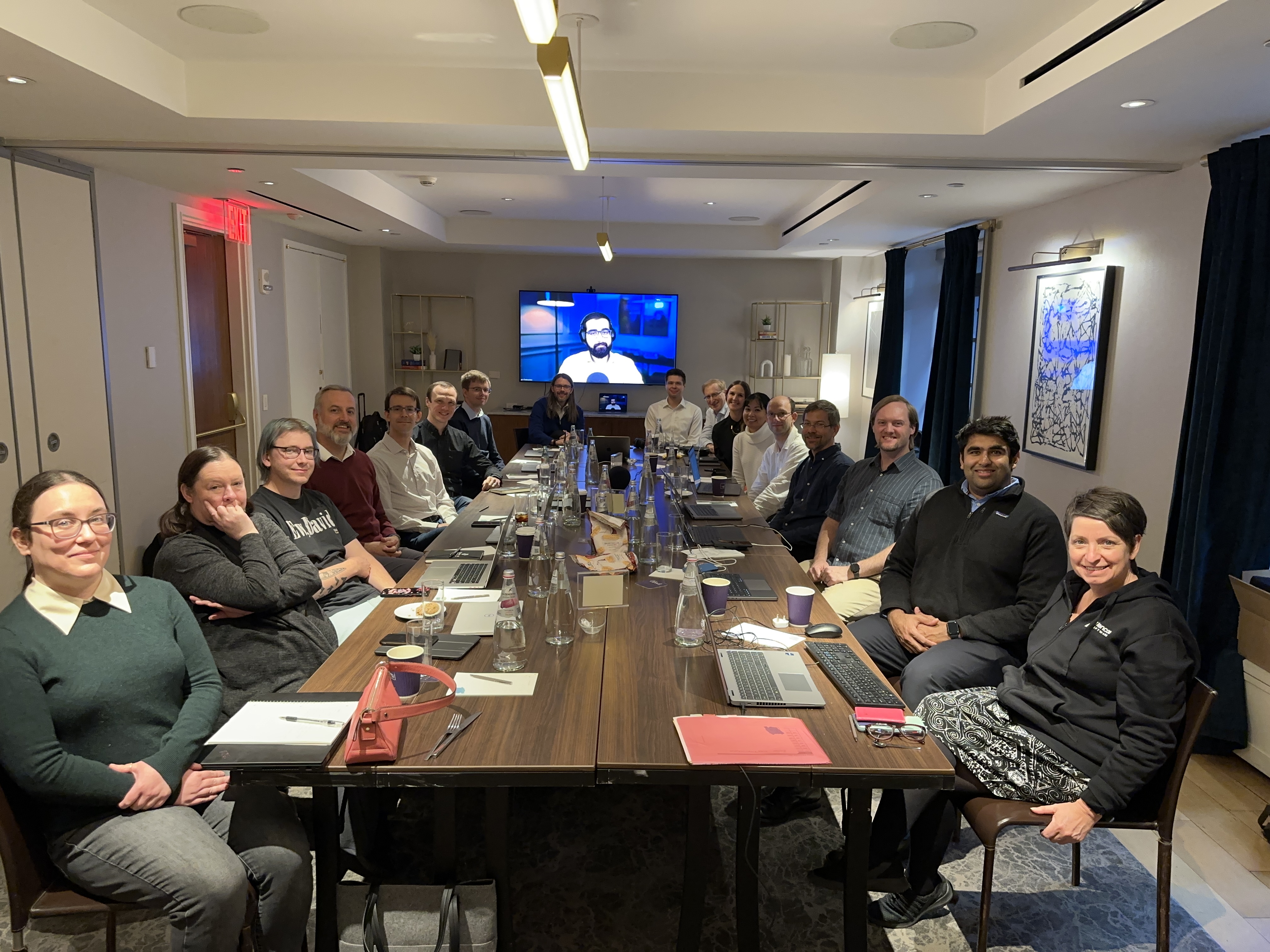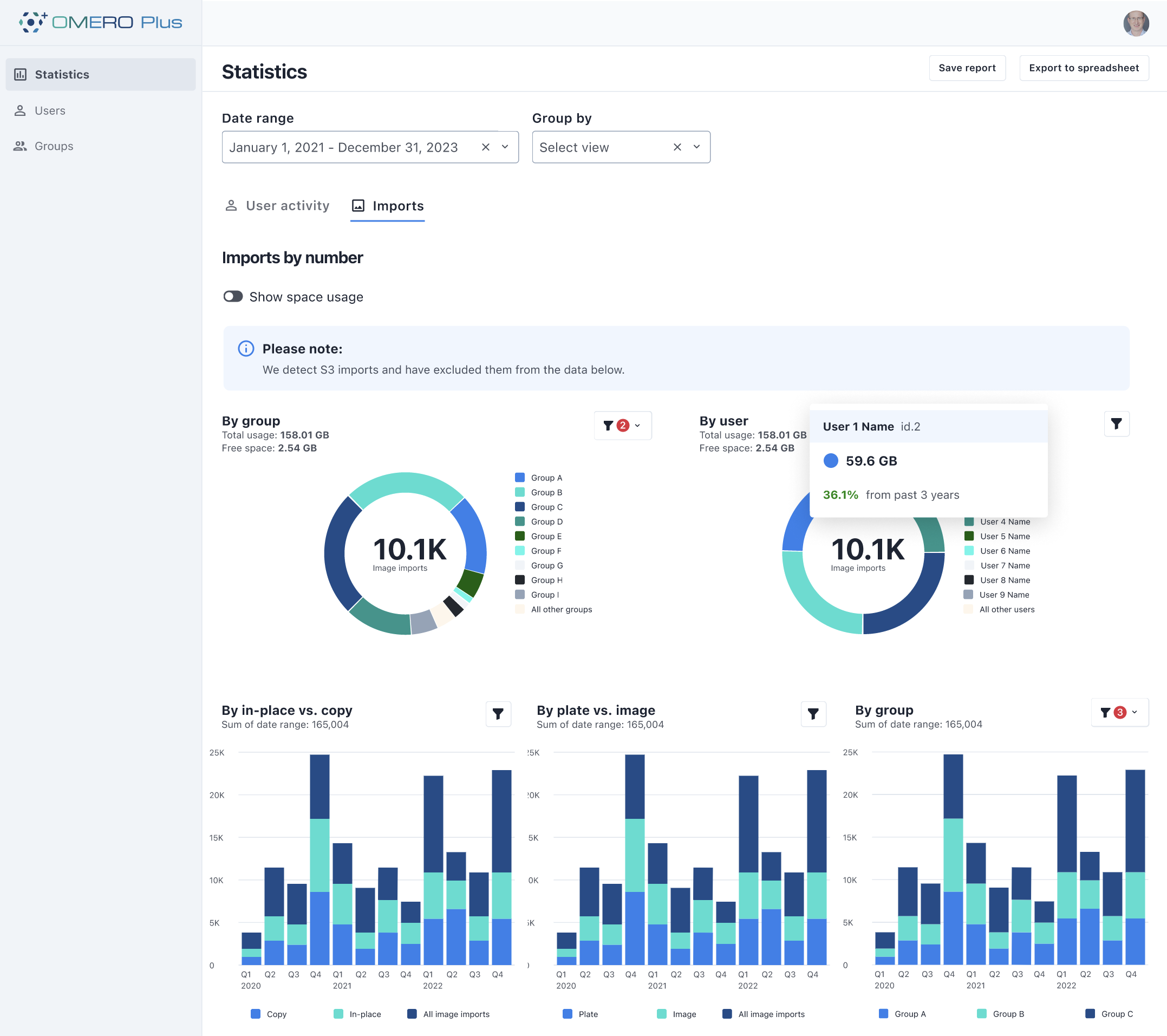As another year of data management comes to a close, we at Glencoe Software are reflecting on the successes achieved this year and the exciting challenges we will address in the upcoming year.

The Glencoe Software team gathered in-person to strategize on the next big challenges in image data management.
Cloud Native OMERO Plus
Increasingly, our customers need scalable, cloud-based data resources for shared data repositories used for histology review, screen data mining, or AI-based object classification. Since the publication of the justification for and specification of an open standard for cloud-native bioimaging data in 2021 (so called Next-Generation File Formats), Glencoe Software has been moving toward such a cloud-first data management solution; in 2022, we announced support for OME-Zarr in OMERO Plus, thus making bioimage data management in the cloud possible for the first time.
While we have announced various improvements in our support for OME-Zarr across 2023, we have further plans to extend the specification of and support for Next-Generation File Formats in 2024. Specifically, Glencoe Software will develop and implement (readers and writers) a specification for an indexed OME-TIFF, which can be read efficiently directly from S3. Our first target data type for the specification will be lossily compressed RGB data from brightfield whole slide images, as this domain is particularly poorly suited for current implementations of OME-Zarr, which does not support lossy compression. We expect to announce our first progress update in Q2 2024.
Further, we recognize that saving on cloud storage may involve archival strategies and other complex storage architectures. OMERO Plus will take its first steps into being more storage aware by supporting the setting of an image’s archived status, along with displaying this status in web-based clients like PathViewer. The OMERO archival data model will be announced in Q1 2024.
Each of our customer’s deployments is unique, and we are proud of our custom support and flexibility in adapting to the requirements of varied institutions. In contrast, however, one advantage and expectation of working in the cloud is the use of technologies to ease rapid deployment and update of a platform like OMERO Plus, broadly within the category termed Infrastructure as Code (IaC). While Glencoe Software has undertaken custom IaC projects with specific customers, we have never before supported a cloud-first OMERO Plus product using IaC. In 2024, we plan to evaluate the best technologies and use cases for such an offering.
Advanced Data Integrations
Importing data at scale is always a challenge, in particular when moving data into the cloud. To address this, Glencoe Software has developed the Cloud Import Gateway, which supports automated optional file conversion (to OME-Zarr or OME-TIFF) and metadata extraction from files to be imported into OMERO Plus. With multiple options for input data, including the monitoring of S3 buckets, this Gateway is compatible with ingesting data from multiple sites or from multiple external partners such as contract research organizations (CROs).
In the domain of High Content Screening, acquisition systems are often associated with a database to manage both image data and metadata. Because this data management is specific to the vendor’s acquisition system and often is system-specific (not cross-system for multiple instruments), Glencoe Software customers often prefer that this data be imported into OMERO Plus for improved interoperability with other imaging experiments. Unfortunately, export from the vendor’s database for import into OMERO Plus can be a time consuming and manual process. In 2023, Glencoe Software evaluated direct database integration support for multiple popular High Content Screening systems, including Molecular Devices’ ImageXpress, Revvity’s (formerly PerkinElmer) Operetta and Opera Phenix, and Sartorius’ IncuCyte.
We look forward to releasing these integrations in 2024, which collectively make the ingestion and management of image data more seamless, scalable, and interoperable than ever before.
Key Domain: Spatial Omics
In 2023, we announced new and updated interfaces for visual data mining, both in PathViewer and Pageant. In 2024, we will announce our solution for both spatial proteomics and transcriptomics using these key visualization and mining environments as well as the flexible OMERO Plus data model. With improved querying performance on OMERO.tables, users will be able to classify millions of objects based on tens of thousands of custom features.
Generation of quantitative spatial data within OMERO Plus will improve with our release of the OMERO.ai project: a new interface for parameter tuning and launching of image analysis jobs with the OMERO Segmentation Connector. In particular, this connector supports popular open source image segmentation tools like StarDist and Cellpose, in addition to custom models using the ONNX format. Glencoe Software does not prescribe the best method for image segmentation, but lets you integrate and scale your algorithm of choice. In 2024, parameter selection will be even easier with OMERO.ai, which supports a live view of segmentation quality before submitting a larger analysis job.
Key Domain: Cell Painting
OMERO Plus has long supported High Content Screening data, not only in its management within OMERO Plus but in our integrations with CellProfiler and other popular image analysis tools. In 2024, we will announce the updated OMERO Parade Plus, which supports the same visual data mining across plates that our customers know and love, but also improves the connection to data visualization with an updated image preview panel including visualization of segmentation masks. We will demonstrate the utility of such a workflow using the popular Cell Painting method with public JUMP Consortium datasets and pipelines.
The work on OMERO.tables for Spatial Omics will also be able to underpin key functionality for single cell analytics in High Content Screening.
Key Personnel: Data Managers
As a team of individuals committed to image data management, we recognize the role of data managers within our customers’ institutions and their key to the success of OMERO Plus. The questions asked by a data manager regarding usage of the platform (users, imports, data types, etc.) provides information that helps scale OMERO Plus as needed, and proactively, over time. We are excited to release the updated OMERO Plus Admin Dashboard in 2024, with intuitive views of usage statistics and user/group management.

A preview of the usage statistics visible in the OMERO Plus Admin Dashboard. Final user interface is subject to change.
Our commitment to open source
Glencoe Software’s partnership with the Open Microscopy Environment is one we value, and we are proud of our contributions back to the open source community. We have the following priorities for open source contributions in 2024.
Next-Generation File Formats are a key technology used and implemented by Glencoe Software, so we remain committed to both making contributions and setting directions for this project. In particular, we look forward to scoping the changes required to support 3D data in OME-Zarr in order to better support our customers working in domains like lightsheet and volumetric electron microscopy. We also hope that our work toward improving brightfield Digital Pathology handling in OME-TIFF will inform the evaluation of similar work needed within OME-Zarr. Finally, we plan to support the evolution of the specification towards Zarr v3 in the zarr-java project.
Bio-Formats continues to be a foundation for many of our applications. We plan to strengthen our commitment to maintaining and improving Bio-Formats by providing more active assistance to the OME team in planning and delivering new versions. Our goal is to release fixes and new features on a more accelerated schedule, to more closely match the pace of changes across all supported imaging domains.
ZeroC’s Ice is an open-source software used by OMERO for communicating between the client and the server. It needs to be available as a dependency both on the client and server environments, and thus its ease of installation is critical for developers who want to work against their data in OMERO as well as system administrators who want to deploy OMERO. Glencoe Software has recently released pre-built components of ZeroC’s Ice. We will support this key dependency through 2024.
Support Commitments
As always, Glencoe Software is committed to supporting our customers as their use of OMERO Plus and associated data solutions evolve. This year in particular, we are faced with many of our customers migrating away from CentOS/RHEL 7 platforms. We look forward to providing the expert staff time to both advise on and perform these essential migrations to supported platforms.
See you next year!
Thank you for your continued engagement with our efforts in image data management. We look forward to keeping in touch and updating you on our progress in 2024!
Glencoe Software customers make it possible and enjoyable to develop solutions to challenging problems, and we thank you for your continued support and feedback.
